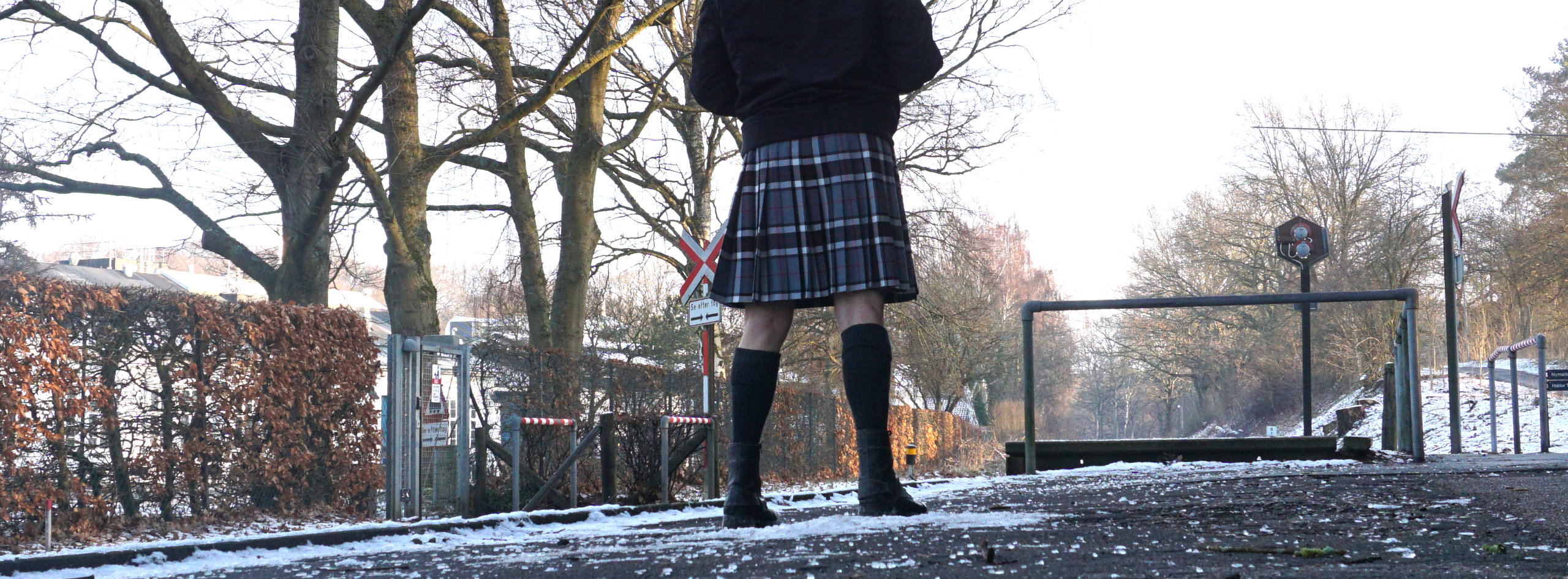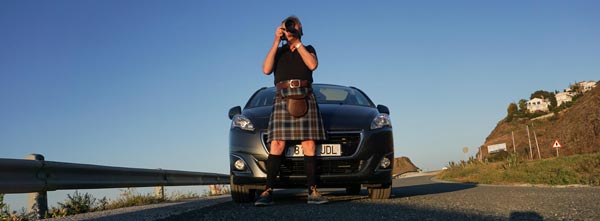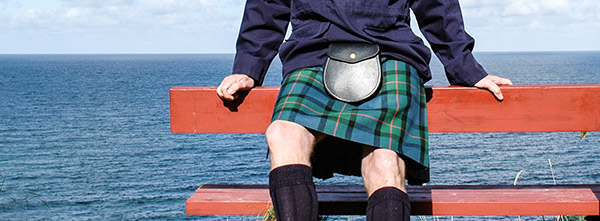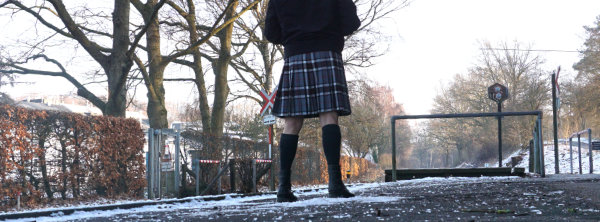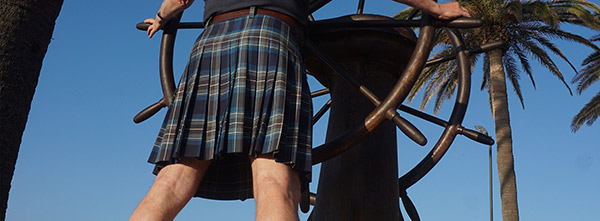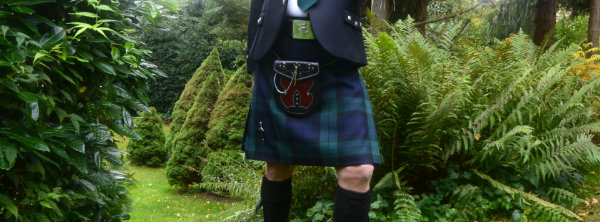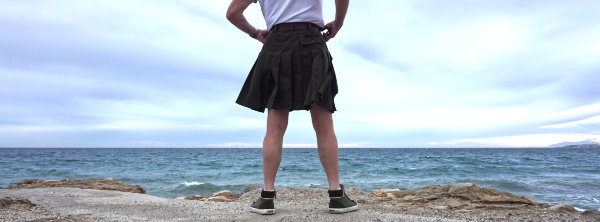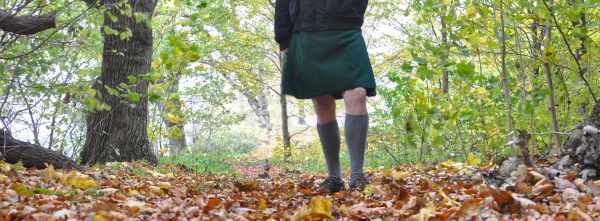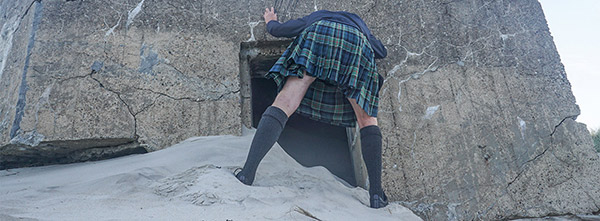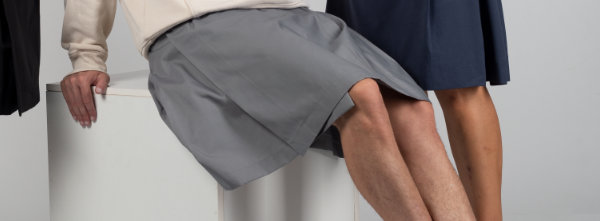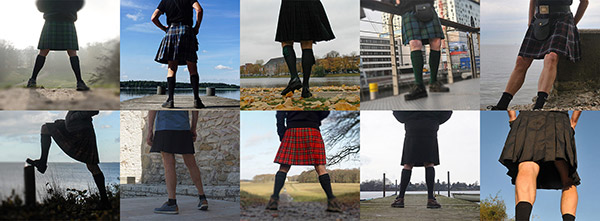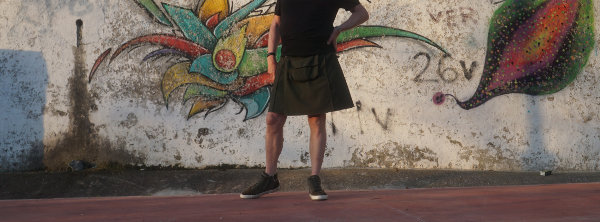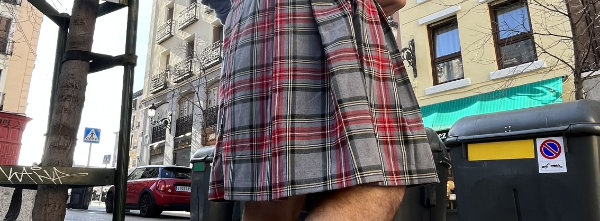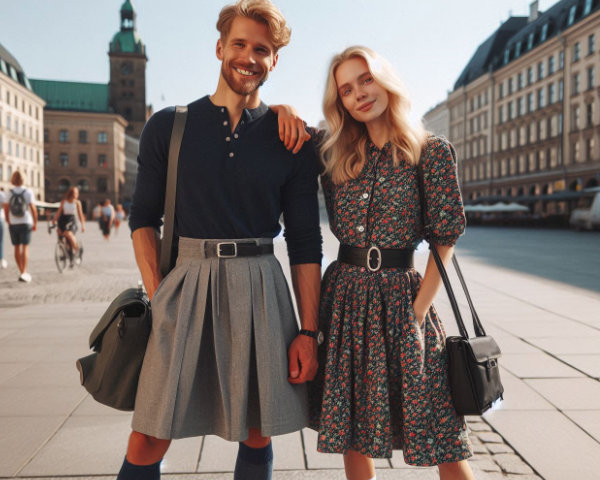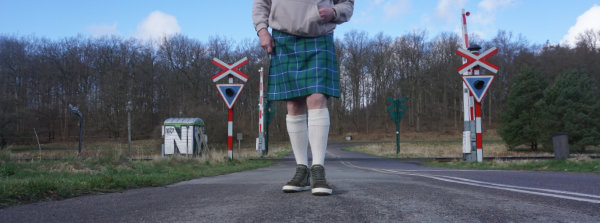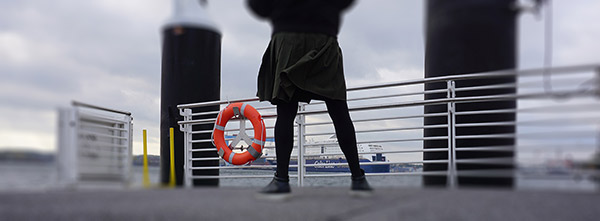What kilt to buy? Purists will say that no less than a 16 oz. 8-yard wool kilt, sewn by hand by a skilled kiltmaker in Scotland or equivalent places shall do. But are they right?
Start looking at your wardrobe. What should a kilt replace or substitute? It is about you and your money and your possibilities for wearing a kilt.
Your kilt should fit its purpose
The kilt is a most versatile garment, which you to a great extent can dress up and down by means of accessories. However, the real all-purpose kilt does not exist. This means that having only one kilt must be a compromise and exclude some functions. Now, what is worse; either having to refrain from wearing a kilt at a wedding or when being on holiday in Rome? The wedding is for some hours, Rome perhaps for a week.
Kilt wearing is for non-formal events
Formal events (black tie and white tie) are not frequent. For many men they are too seldom occurring events for investing in an expensive garment, thus in many cases resulting in hiring rather than buying. This also implies to kilts, of course.
And if you, like me and many, many other kilt wearers around the world, have no Scottish roots, it is rather unlikely that you should ever be invited to an event, where formal kilt wear is an option or mandatory.
Also, a kilt on job instead of a business suit? Maybe for casual fridays, but could you? Would you?
High potential for wearing a kilt are weekends and holidays, and days where you are working from your home and in the evenings.
What you need for these purposes is a kilt to replace jeans, chinos, and shorts, rather than a kilt outfits to replace evening suits and tuxes etc. In other words, a kilt for
casual and
smart casual wear. That said, a kilt for smart casual wear is, with the right accessories also perfect for the opera house, the concert hall, theater, and Michelin restaurants, should so you wish.
A kilt must not be very expensive
Don’t automatically think that only the most expensive kilt shall do. Are your jeans and chinos all labelled Armani, Hugo Boss and the like, it might be true – if the kilt should substitute them, and not your shorts which might be cheaper non-branded ones. For must purposes, less (and cheaper) will do.
Don't believe that an expensive kilt is more 'manly' than a cheaper one, or that a cheap kilt is not considered a kilt.
For people seeing you in a kilt, their first thought is not, whether your kilt is cheap or expensive. It is the fact that you are wearing a kilt. Probably this is their only thought.
Most people, outside Scottish environments, have only seen a kilt in pictures or on TV. How should they know about details, differences in fabric etc? They will connect a kilt with tartans and perhaps pleats. Point.
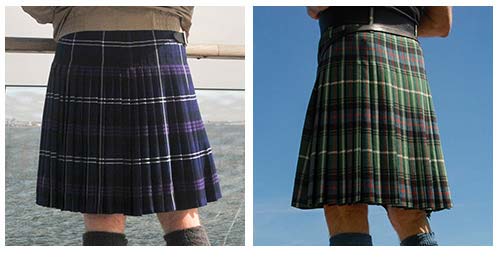 The kilt to the left (Heritage of Scotland tartan) is £50, the one to the right (MacDonald of the Isles Ancient tartan) five-ten times as much. Both are kilts. Like cheap jeans and expensive jeans are all jeans. Like cheap, as well as expensive cars, are cars.
The kilt to the left (Heritage of Scotland tartan) is £50, the one to the right (MacDonald of the Isles Ancient tartan) five-ten times as much. Both are kilts. Like cheap jeans and expensive jeans are all jeans. Like cheap, as well as expensive cars, are cars.
Dress to impress?
No doubt, you know the expression, dress to impress. If that is what you have in mind, better than invest in that extremely expensive kilt think other possibilities. Only very few connoisseurs, whom you after all shall never meet, shall be able to give you credit for this Rolls Royce of a kilt.
Shirts with a logo, Ralph Lauren, Tommy Hilfiger et al, are signalizing something to most people. So do watches like Rolex, Philippe Patek, TAG Heuer, and Omega. Wearing them makes your thrifty kilt look like a million. The world asks to be fooled.
By the way, the newest iPhone makes it only 14 days, then everybody has one.
How should your kilt be made?
A skilled, experienced kiltmaker, doing every single stich by hand, can make a kilt a piece of art. It takes hours and hours and hours. No wonder that such kilt has its price.
That said, a skilled, experienced kiltmaker, primarily using the machine can make very, very nice kilts, too.
Even a woman with her skills only coming from making kilts day in, day out, perhaps in a factory in Sialkot, Pakistan, might be able to produce kilts like if by magic, especially if she was given just a little bit more time than when making the cheapest of kilts. It is called learning by doing.
I have been wearing kilts for almost 30 years by now. Except for arranged get-togethers with other kilt enthusiasts, I think, I might have seen men in kilts less than 20 times and only from a distance, making it not clear, whether the kilt was expensive or less so. Besides, I couldn’t care less. The important thing for me was and is seeing another man in a kilt.
Are 8 yards preferable over 5 yards or less? And 16 oz. over 13 oz. or less
If you want the ‘tank’. Yes. The kilt with the correct swing, as they say. But less will do and might often be better – depending on the context in which you shall wear it. To my opinion, eight yards of fabric around me, even if lightweight, is quite a bit. I'll say 5 yards for me; 4 or 3 yards being ok too.
A 16 oz. kilt is fine on a cold day, or at a dress-up event. Formal clothes have never been comfortable, but that is the way it is.
When temperature exceeds 5C/41F a 13 oz. kilt feels much more comfortable – to me. At 25C/77F I think an 11 oz. one is better, or even an 8 oz.
Wool or PV?
Wool, no doubt, is the best-looking fabric. A minus is that a wool kilt cannot be washed, it must be dry-cleaned. It is warmer in the winter – and in the summer - than PV.
PV is available in different qualities. Some cheap fabrics peel, others, especially those coming from British mills, like Marton Mills, are fine and make excellent kilts for casual and smart casual wear, and even heavy rain is no problem. They shall get wet but are drying fast without needing much aftercare, if any.
Ready-made or made-to-your-measures?
Until about five years ago, cheaper kilts would be off-the-peg. They would come in four-five different waist-sizes, in 7-8 different tartans, and in a standardized 24" or 61 cm length. They were typically made in Pakistan or China and sold by kilt shops in North America and Europe, especially Scotland.
Today, even cheap kilts are offered made-to-measure. You order your kilt by vendors with addresses in for example USA, UK, France, and Germany, whereafter the kilt is sewn in the city of Sialkot in Pakistan, from where it is shipped to you. The system functions, and your kilt is hardly more expensive than a ready-made one. Ready-made kilts are still to buy.
Kilts, sewn in Europe or America are, with a few exceptions, always made to your measures.
The price is not just the price
Unless you live in Scotland, it is likely that your kilt is ordered online, and that you and your vendor live in different countries. Borders often mean additional cost, and kilts are no exception. Check the conditions your country.
For EU-citizens, import duty, customs declaration fee, and customs duty apply when buying from a country outside the Union.
Want to see the rules,
klick here.
Otherwise just go on.
Shipment
No matter where you buy online, shipment must be paid for. Within the European Union, it is rather cheap. Otherwise, the longer the vendor from Europe, the higher the shipment cost.
An exception is Pakistan, from where shipment in general is cheaper than from UK and espacially from USA. But take a look on the websites. You might be positively surprised.
Taxes
All countries, not being part of the European Union, are considered 3rd countries which means additional cost:
Customs Duty
Customs duty is 12% on kilts and accessories. However, there are exceptions:
1. If the total value of the goods doesn't exeed the equivalent of 150 Euro, so far, no customs duty is charged!
2. If the goods are manufactured in UK and you buy them from a British vendor, no customs duty applies. This is due to a trade agreement between the Union and UK.
Import Duty
Import duty or import tax replaces your country's VAT and is the same rate. It adds to the price by 16% to 25% depending on your country's VAT-rate. EU avarage is around 20%.
Exception: When buying in UK, the vendor shall deduct the 20% British VAT, in order that you shall not pay it twice. In most cases, the price you see, is without VAT when you visit the site from an EU-country.
Import duty is calculated on price of goods plus customs duty plus shipment cost.
Customs Declaration Fee
A customs declaration fee to be paid to the courier company always applies for goods, shipped from a 3rd country. It varies with the courier but may be up to 20 EUR, making the fee the dark horse in the calculation. Some courier companies might charge you less for small orders.
Important
Pakistani kilt manufacturers will often register companies in Europe, US etc. If you order a custom kilt or accessories from a branch within the European Union, for example Germany and France, you should avoid taxes, and sometimes you may, but according to the business model, the goods might be shipped directly to you from Pakistan. Obviously, a grey zone. By all means, be prepared to pay taxes.
Your first kilt and where to buy it?
Below you'll find advice on buying kilts for casual and smart casual wear. There shall be two categories,
1. Affordable kilts, sewn in Pakistan
2. Casual and traditional kilts, sewn in Scotland, USA, Ireland, and Austria
1. Affordable Kilt sewn in Pakistan
The existence of affordable kilts is to my opinion the necessary condition of having more men in general start wearing a kilt.
Now, what is affordable, what is expensive, and what it too expensive? It is most individual, of course, but I should say that to many men, an affordable kilt is around 100 dollars, pounds or euros, delivered at their doorstep. This implies that the kilt itself shall cost no more than $/£/€60-70 to accommodate for shipment, tax, and declaration. Unfortunately, no Scottish made kilts are to have within this price category, not even ready-made ones. A Scottish kilt shall cost 2-3 times as much and very often, considerably more. But, fortunately, in Pakistan, especially in the Northeastern city Sialkot, very many enterprises are making and selling affordable kilts.
But how about quality? Even the cheapest kilt can be too expensive if the quality is inferior. I have bought two such kilts - from a British and an American vendor. They had in common that the fabric peeled and soon made the kilts look miserable. The cheaper one, a £30 kilt from UK, litterally fell apart after a few wearings. Cheap, made to be cheap, can be too cheap to also be good. Therefore, better avoid the cheapest of kilts.
I have two makers/sellers of Pakistani made-to-measure kilts to recommend:
affiliated with American registered
Kilt & More, and French
Kilt Homme.
In October 2021 I dared order a 5-yard kilt in Moffat tartan. The price was 37 EUR, freight 17 EUR.
Only two weeks later I had my kilt delivered. And without any taxes to pay.
That a manufacturer has a business address within EU, is, like said earlier, no guarantee that you can avoid taxes. The construction with your kilt being sent directly from Pakistan is, no doubt, within a grey zone. Sometimes you pay, sometimes you do not. I have heard about other of their customers who had taxes charged.
What did I get?
A well-fitting, and – after some ironing - very nice-looking kilt with a pleating well above average and with the poly viscose feeling good, even if not in the same league as polyviscose from say British Marton Mills.
For casual wear, it is simply perfect. I have worn it a lot and it is not to see. Therefore, I can give give it my best recommendation.
 Some flaws in pleating...
Some flaws in pleating...
 ... but from a normal distance, pleating looks fine.
... but from a normal distance, pleating looks fine.
 Autumn
Autumn
 In the city
In the city
At a normal distance between people, hardly anyone shall observe the few flaws in pleating, and should they, are all things in their own life perfect? Home, car, clothing or just life?
I'm happy with this kilt and still very often wear it.
Championkilts.com
In December 2022, I came across another vendor of Pakistani-made kilts, Championkilts. Their website looked good and functional, and they had some nice tartans, as well as pretty stylish accessories.
Should I give this company a try? I did. I am glad I did.
Quality of fabric, sewing, and precision in pleating, everything is fine. The price, $99 was higher than that of most kilts on their website, but it might be due to the tartan and fabric, and it is an 8-yard kilt.
Nevertheless, it is the best kilt, I have tried, not made in Scotland or USA. This makes it definitely a Best Buy. Championkilts, therefore, has my highest recommendation.
The tartan is Hebridean Heather.
Despite Champion Kilts have an American business address, their kilts are shipped to you from Pakistan, NOT from the US. This means low shipment cost, compared to what you should pay, if the kilt was sent from USA!
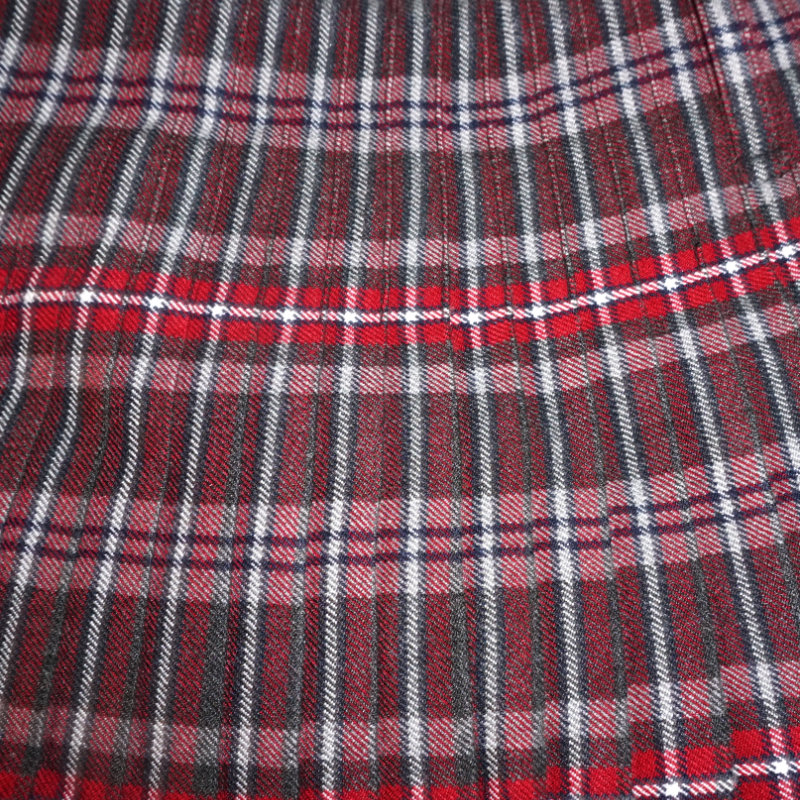 Very well-pleated kilt
Very well-pleated kilt
 Kilt from Champion Kilts in the city.
Kilt from Champion Kilts in the city.
 In the harbour.
In the harbour.
 Kilt from Champion Kilts
Kilt from Champion Kilts
On Links Page #1 you might find several other enterprises offering affordable made-to-measure kilts. With them I have no experience, however.
Vendors of ready-made kilts
You can still buy ready-made kilts. Most likely they are made in Pakistan or China. They are a little cheaper than Pakistani made-to-your-measures kilts and they can be delivered faster. But, like said already, their 24" length must fit you.
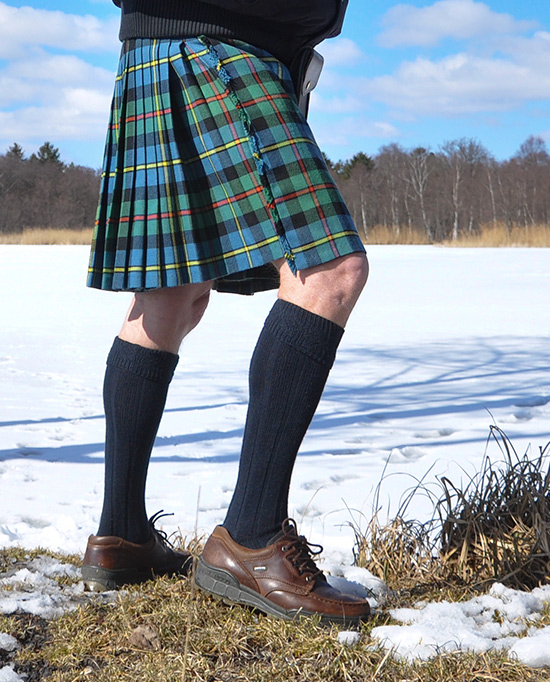 This 5-yard, approx. 16 oz. readymade PV kilt I bought back in 2007 from Heritage of Scotland.
This 5-yard, approx. 16 oz. readymade PV kilt I bought back in 2007 from Heritage of Scotland.
MacLeod of Harris tartan. I still wear it. They no longer sell this tartan.
 Heritage of Scotland Gents Full Deluxe Kilt, 8-yard ready-made, 16 oz. PV. Heritage of Scotland tartan.
Heritage of Scotland Gents Full Deluxe Kilt, 8-yard ready-made, 16 oz. PV. Heritage of Scotland tartan.
I never bought a kilt from The Scotland Kilt Company, but their homepage looks fine and serious. Also, their accessories are looking good, and prices seem most reasonable.
2. 'Casual' and 'traditional' kilts
A step up the ladder, you can from Scotland and USA have high quality 'casual' kilts made of PV from British mills. Especially here they are superior to Pakistani competition.
In this category you also find casual kilts made of wool as well as machine sewn 'traditional style' wool kilts. These are typically 13 oz. 5-yard kilts, but often you can have these kilts in any tartan weight and yardage you wish.
If you are prepared to pay 2-3 times more than for an
affordable kilt made in Pakistan, a casual kilt made in Scotland or in the US is what to go for.
What is the difference between 'casual' and 'traditional'?
Very little. Some Scottish and American kiltmakers or vendors will position their cheapest kilts as being casual, probably in the hope that they shall not cannibalize their more expensive ones, which they'll call 'traditonal, too much. But of course, there are also real differences. Casual kilts are machine-sewn whereas their more expensive 'traditional' siblings might be sewn by hand for even better precision. And then casual kilts are sometimes made of PV instead of wool, and/or there are savings on the yardage and the tartan weight. i.e., from two to six yards and 10-11 oz, some 13 oz, rather than eight yards and 16 oz. One of the kilts, I'm going to recommend is really lightweight, only 8 oz.
It is to note, that the PV used for these kilts typically is in a very high quality from British mills.
On some expensive kilts, there is an additional rise. This you'll not find on any casual kilt. The extra rise may be fine if you are wearing a waistcoat and a Prince Charlie jacket, but that you are not for casual wear. And even for the concert hall, the opera house, the theatre, and the Michelin restaurant 'casual' kilts, at least the ones in wool, worn with a kilt jacket, are all you need.
I shouldn't forget to mention that the fact that most 'casual' kilts are
11 oz or 13 oz, means that they might feel and look more comfortable on hot summer days in Southern Europe than 16 oz. kilts. All Pakistani kilts come in a 16 oz equivalent fabric, probably to having them feel closer to expensive Scottish, 'traditional' kilts.
Most of my own kilts are 5-yard, 13 oz wool kilts and made in Scotland. Unfortunately, the vendors, from whom, I over the years, have got them, are no longer existing or are no longer offering custom-made kilts. Therefore, I only have experience with very few of the vendors below.
Made in Scotland
Clan, a major Scottish kilt vendor, earlier known as Scotweb, has a very well designed and functioning web site.
To emphasise is their
Essential Casual Kilt, a 5 yard kilt sewn in Scotland to your measures in UK-made high quality poly viscose.
CLAN is also selling a five yard made-to-measure
Casual kilt in pure new wool "with a contemporary lower-waisted cut" which isn't a bad thing for a kilt to be worn casually.
Another possibility is a
seven yard traditional kilt.
Further they have high-end 8-yard kilts, leather kilts, camouflage kilts and denim kilts in their assortment.
5-yard 10 oz. Mens casual kilt. Available in really many tartans. Also more expensive traditional kilts.
Highland Store
2-yard wool off-the-peg kilts.
Highland Store has a physical shop in London, Holborn
66 Great Russell St, London WC1B 3BN close to British Museum.
Two yards for a kilt aren't much. But when in 2009, I was in London, I tried this kilt on. By then the price was £75 and today, it is over £100 more. But I liked the kilt and afterwards I regretted that I had not bought it.
If it is to be sent to an EU-country, it shall become too expensive, I think, but if you are in London, visit the store, and if you like this kilt and buy it, and you save freight and declaration fee, it might not be that bad.
Highland Store also sells traditional kilts.
St. Kilda Kilts, Glasgow
The kilt is to have in a lot of different tartans and, best of all, the fabric is 11 oz. poly viscose from Marton Mills, the same as used for one of my favourite kilts, the USA Kilts Casual, described below.
Add to this that the price seems most competitive. Therefore, it makes a great ‘European’ alternative to the USA Kilts Casual, this suffering from no VAT to deduct, and extremely high shipping cost.
Since mid-March 2024, I have this kilt in MacKay tartan. In fact, the hardest decision was choosing the tartan, with so many very nice ones available.
 My new 5-yard St. Kilda Casual kilt in MacKay tartan, after having just unpacked it.
Excellent quality. I like it having only two buckels and straps.
My new 5-yard St. Kilda Casual kilt in MacKay tartan, after having just unpacked it.
Excellent quality. I like it having only two buckels and straps.
According to St. Kilda Kilts, the low price has been made possible because the kilt is
top-stitched, meaning the pleats at the fell are stitched from outside and accordingly visible, rather than by far more time-consuming process of stitching them from inside, like on my more expensive kilts.
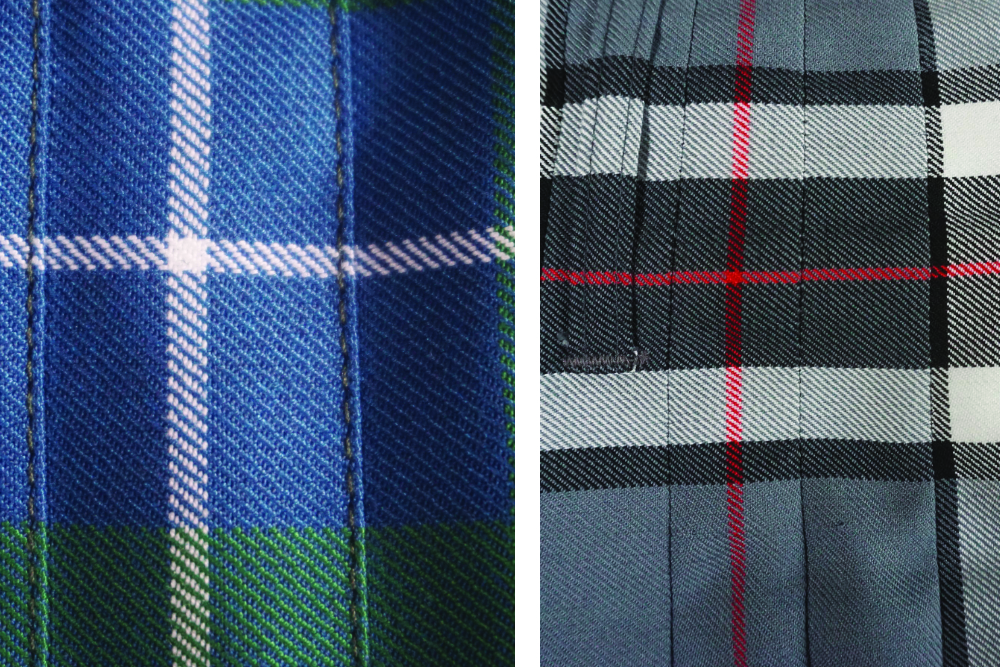 Do you see the difference? The St. Kilda kilt to the left is top-stitched. From a distance exceeding one meter or yard, you shall not be able to see it. And how many, not deeply involved in kilt wearing, shall know what is better?
Do you see the difference? The St. Kilda kilt to the left is top-stitched. From a distance exceeding one meter or yard, you shall not be able to see it. And how many, not deeply involved in kilt wearing, shall know what is better?
It
might, at least in theory, also influence the stability of the kilt, but not on a lightweight 5-yard kilt like this.
As a matter of fact, my USA Kilts Casual is top-stitched too, as are my Pakistani-made kilts, something with which I have not the slightest problem. I very much doubt that anybody shall be able to notice the difference. And should they, very few should know what the better technique was.
No doubt, in order to save cost, there are only two buckles and straps, where many other kilts have three. I prefer two over three, and have several times asked vendors to omit the third one, when I have ordered a kilt. No problem.
On expensive kilts, the straps, to which the buckles are fastened, are made of leather. On this kilt (and most other affordable kilts) they are in the same fabric as the kilt. Don't worry; they are strong enough to secure your kilt. And as soon as the kilt is fastened around you and covered by a belt, nobody can see them. No problem.
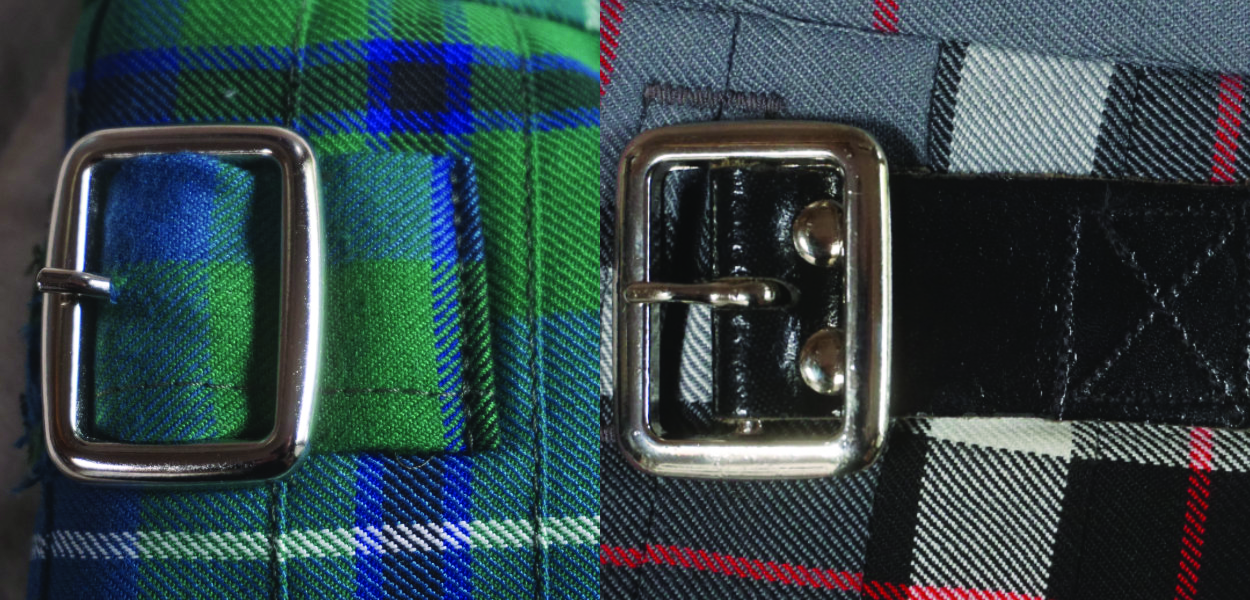 The straps holding the buckles are only to see until covered by a belt.
The straps holding the buckles are only to see until covered by a belt.
In other words, only 'invisible' and of-no-importance compromises, necessary to keep price down.
A minor 'complaint': For added flexibility, I should have liked the straps just a bit longer.
In fact, instead of buckles and straps, I should have been OK with a Velcro closure like on the
USA Kilts Casual or on the
Sport Kilt in its basic version, perhaps with a possibility to step up to straps and buckles. It had made the kilt machine-washable and 'airport-friendly'.
 MacKay. A beautiful tartan and high quality 11 oz. poly viscose.
MacKay. A beautiful tartan and high quality 11 oz. poly viscose.
 Split, Croatia. 5-yard 11-oz. casual kilt from St.Kilda Kilts, Glasgow. Mackay tartan.
Split, Croatia. 5-yard 11-oz. casual kilt from St.Kilda Kilts, Glasgow. Mackay tartan.
 MacKay tartan. Kilt worn in Prague
MacKay tartan. Kilt worn in Prague
 Split, Croatia. An 11 oz PV kilt is perfect on a hot day.
Split, Croatia. An 11 oz PV kilt is perfect on a hot day.
You can have this casual kilt it in very many different tartans as well as solid coloured.
The price was £100 ex British VAT and shipment £45 with DHL. On top, I had to pay local VAT plus the equivalent of £14 for the declaration.
Nevertheless, if you can/are willing to spend some extra money, compared to a 50-60 $/£/€ kilt, this St. Kilda Casual kilt shall, due to its very high sewing quality and fine fabric, available in so many attractive tartans, and despite Brexit and related added cost, give European kilt wearers fantastic value for their money. Go for it. It's worth it.
You can have a
5-yard casual wool kilt from St. Kilda Kilts, starting at twice the price of their poly-viscose casual. Here you can choose tartans from
House of Edgar, Lochcarron, Marton Mills, and
Strathmore.
Traditional kilts
They also have more expensive 'traditional' kilts to offer.
Made in Scotland - vendor in Germany
Kilts & More
Kilts are made in
Scotland but the vendor is situated in Germany, more precisely in Mühlhausen, a few kilometres south of Heidelberg. They even have a store to visit, Hauptstraße 74, D-69242 Mühlhausen with opening hours Monday-Friday 10-14.
The fact that Kilts & More is based in Germany means that EU-citizens shall avoid the customs clearance fee. Freight within EU is favourable.
Interesting is a 6-yard PV
'Sports Kilt´ made to measure. The fabric is from Marton Mills and the same as used for the St. Kilda Casual kilt. Many tartans to choose.
Despite no taxes and cheaper shipment, the price, delievered at the door step, is a little higher than that of the St. Kilda kilts. But also this one looks like a very good kilt.
Note:
Kil
ts & More Europe is
NOT to be confused with Pakistani Kil
t & More/Schottenrock.de!
Kilts & More also has a base in Scotland, but warehouse and physical store is in Mühlhausen, Germany.
Made in England
Paul Henry
will make you an excellent traditional kilt, as well as kilts in tweed, denim etc. Should I one day be in the market for a kilt costing over 400 pounds, he is one, I should contact. Paul Henry is not making kilts for a living, but he has a very good reputation.
Made in Ireland
OND - O'Neil of Dublin
Readymade 5.5-yard lightweight kilts in pure worsted wool. Tartan weight could be about 10 oz., hardly anymore. Since the kilts, like skirts, have no lining, they really feel lightweight, yet stable. Five different tartans. Length 59 cm/23".
 O'Neil of Dublin Kilt, Stewart Black tartan
O'Neil of Dublin Kilt, Stewart Black tartan
 O'Neil of Dublin kilt, Stewart Navy tartan
O'Neil of Dublin kilt, Stewart Navy tartan
The Stewart Navy tartan is no longer available. I have four of these kilts from O'Neil of Dublin.
Prices might be to the high side, but Ireland being an EU-country and free shipment for orders over 50€ means no additional cost for EU-citizens. And fabric and sewing quality is excellent.
Made in USA
With maybe two exceptions, high shipment costs and custom duties, combined with generally hopelessly oldfashioned websites, make American kilt makers and vendors non-competitive and uninteresting for European kilt buyers. The exceptions are USA Kilts and Sport Kilt.
USA Kilts is a family company, owned and driven by Rocky and his wife together with dedicated employees.
Their
USA Kilts Casual is a 4-yard kilt, made to your measures. The price is $140 for adults.
The fabric is British made fine PV and the sewing quality is excellent. The kilt is not lined. Nevertheless, it s very rugged, and a fine thing is, that it is washable and dries fast.
Being closed by means of Velcro instead of straps and buckles it has no metal parts, making it the perfect choice when you must pass through airport security. I have been wearing my USA Kilts Casual onboard several airplanes.
If you are living in the USA and have no high shipment cost, VAT, and custom clearance fee to pay on top, don't look any further. Buy one, two, three, five of them. Not because they are not durable enough; they are, but for sheer variety.
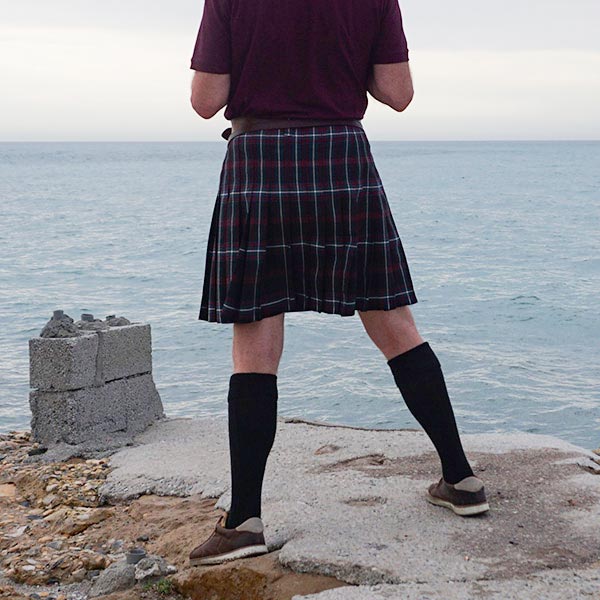 USA Kilts Casual, American Heritage tartan. Costa del Sol, Spain. I bought mine second hand back in 2012, and it is a kilt I wear again and again.
USA Kilts Casual, American Heritage tartan. Costa del Sol, Spain. I bought mine second hand back in 2012, and it is a kilt I wear again and again.
Since I got my USA Kilts Casual it has been with me on most holidays.
By the way, USA Kilts really do something to promote kilt wearing. Just one example are YouTube videos, where the owner, Rocky, gives good advice, wearing a kilt himself. It should be a natural thing. For Rocky it is, for many other vendors, it not always is.
American Sport Kilt makes lightweight kilts for men, women, and children.
The Sport Kilt Original is only 8 oz. And the fabric looks and feels like cotton.
In its basis version it is closed by Velcro, like the USA Kilts Casual, but it has not sewn-down pleats and no belt loops. The belt loops you can live without, but sewn-down pleats are a must, I think. Fortunately, you can have it all, sewn-down pleats, belt loops, straps and buckles, and fringes. And you can have the Sport kilt in other lengths than the standard 22.5". It is just a question of paying extra.
A most interesting feature is the possibility to have inside, deep slide pockets. They are worth every one of the 24 dollars they shall cost you.
Only, if you want it all, it can end up being rather pricy.
I have a Sport Kilt. Mine is with sewn down pleats, invisible deep slide pockets, fringes, and belt loops. The thin fabric makes it a dream to wear under Southern European sun.
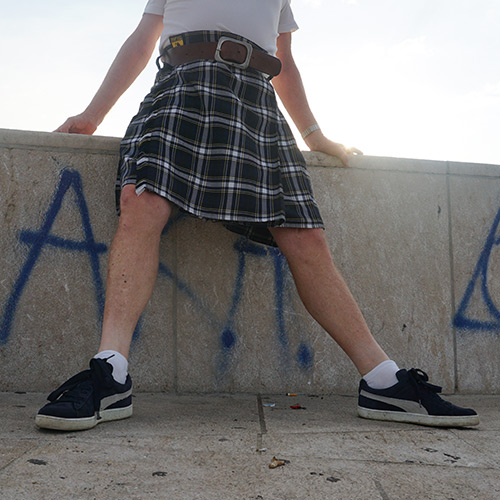 Ultra lightweight Sport Kilt comes in a lot of different tartans.
Ultra lightweight Sport Kilt comes in a lot of different tartans.
When ordering you can upgrade it to have sewn-down pleats,
belt loops, and slide pockets, fringes, and straps and buckles.
Loch Ness tartan, Split, Croatia.
For informal occasions where you might otherwise feel comfortable in shorts, the Sport Kilt Original is great –
provided you don’t expect it to be a traditional kilt. It is not. It’s an unpretentious kilted garment of its very own. But for the mentioned purposes I can recommend it, even if freight and taxes shall more than double the price when sent to Europe.
Kilts a la Austria
If you are not Scottish and your kilt consequently doesn’t need being Scottish in its expression, you might find this kiltmaker interesting:
Rettl 1868
In Carinthia in Southern Austria high fashion company Rettl 1868 also makes top quality ‘Austrian’ style kilts, primarily to be worn at smart casual wear events, it seems.
I know of no kiltmaker who has done and still does so much for promoting kilt wearing as the owner of Rettl 1868,
Thomas Rettl.
In his high quality, most professionally lay outed online magazines,
Rettl & Friends
his kilts are shown along with Rettl's other designs for men and women and also, he every year will arrange several events like
The Kilt Ski Day with various competitions. Many locals will come in kilts, as a natural thing, men in Lederhosen and women in Dirndl also being welcome. 1st prize might include a Rettl kilt.
In the pictures, Thomas Rettl will most often be wearing a kilt himself. How often do you see Scottish kiltmakers in a kilt?
 An example of the Rettl & Friends Magazine with high quality photographs and ads from other companies offering high end products within other product categories.
An example of the Rettl & Friends Magazine with high quality photographs and ads from other companies offering high end products within other product categories.
The Rettl kilts have their own tartans and design, being different from Scottish kilts. The same implies to sporrans, jackets, and other accessories.
Therefore, don't judge these kilts and how they are worn with "Scottish eyes". They are not intended to be Scottish. They are Austrian, are their very own.
Prices are around 650 € or approx. £535. Expensive, yes. But these kilts might be as durable as Austrian Lederhosen. They are made to be worn. And to EU-citizens neither customs duty, nor declaration fees apply.
Conclusion
My suggestion for a first kilt should be either a casual kilt or a 5-yard kilt made in Pakistan. You can easily find kilts costing twice or three times more than the kilts I have suggested here. For casual wear or an evening in the opera house, I just think, you don't need them. But your needs, your money, your choice.
On the Links #1 page you can find makers of those fine kilts.
Be aware, that by buying a kilt, kind of addiction might have started, so probably you'll not end up with having just one kilt.
